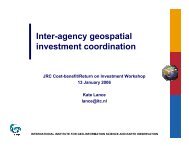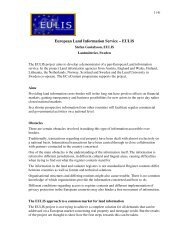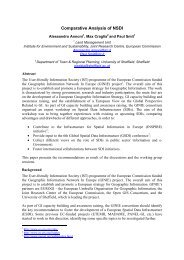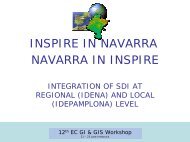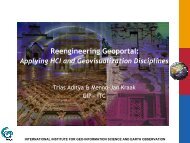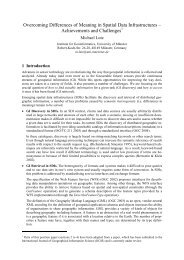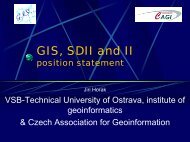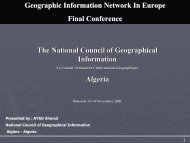Survey of key GI players within Europe - EC GI & GIS Portal
Survey of key GI players within Europe - EC GI & GIS Portal
Survey of key GI players within Europe - EC GI & GIS Portal
You also want an ePaper? Increase the reach of your titles
YUMPU automatically turns print PDFs into web optimized ePapers that Google loves.
This survey and report is closely related to these <strong>GI</strong>NIE reports:<br />
• The <strong>Survey</strong> and Analysis <strong>of</strong> National <strong>GI</strong> Associations;<br />
• The Analysis and Capacity Building Report <strong>of</strong> the National <strong>GI</strong> associations;<br />
• The Final Report and the Recommendations for Action resulting from the <strong>GI</strong>NIE Data Policy<br />
Workshop;<br />
• The <strong>Survey</strong> <strong>of</strong> Pan <strong>Europe</strong>an <strong>GI</strong> Organisations (Sep 2003);<br />
• The <strong>GI</strong>NIE consultation document and reports on the AB<strong>GI</strong>.<br />
General information<br />
A synopsis <strong>of</strong> this report and all <strong>of</strong> the above mentioned reports will feed into the <strong>GI</strong>NIE final<br />
Conference report that will be prepared and printed during September and October 2003 in time for<br />
the final <strong>GI</strong>NIE conference that will take place in Brussels on the 13 th & 14 th November 2003, which<br />
will be targeted at up to 100 politicians and senior decision makers <strong>within</strong> the <strong>EC</strong>. Information<br />
regarding the <strong>GI</strong>NIE project can be obtained from the web site: http://www.ec-gis.org/ginie/<br />
Definitions<br />
What do these words mean – “the <strong>key</strong> <strong>GI</strong> <strong>players</strong> in <strong>Europe</strong>”? The last part is perhaps the easiest<br />
part; for the purposes <strong>of</strong> this survey the countries which have been included in this definition <strong>of</strong><br />
<strong>Europe</strong> are those listed in the “scope” section above. The more difficult elements are “<strong>key</strong> <strong>players</strong>”<br />
and “<strong>GI</strong>”.<br />
Taking <strong>GI</strong> to begin with, not everyone’s idea <strong>of</strong> <strong>GI</strong> is the same. Most experts agree that <strong>GI</strong>S<br />
technology includes hardware, s<strong>of</strong>tware and digital spatial data. They also agree that <strong>GI</strong>S generally<br />
includes query, analysis and graphic display and output capabilities. But because <strong>GI</strong>S is suited to a<br />
range <strong>of</strong> applications, users and disciplines, people in the industry rarely agree on the definition <strong>of</strong><br />
<strong>GI</strong>S. It is even difficult to agree on a name for the technology; it can be geographic information<br />
systems, desktop mapping, spatial information systems, geographical information systems or even<br />
geomatics. Defining the <strong>GI</strong> industry as a whole is even more complex. Many technologies and<br />
products are <strong>of</strong>ten included as part <strong>of</strong> the industry definition even though they don't meet many <strong>GI</strong>S<br />
definitions. Part <strong>of</strong> the reason is that <strong>GI</strong>S can be considered a subset or superset <strong>of</strong> other things such<br />
as image processing, computer-aided design, database s<strong>of</strong>tware or computer cartography. Because<br />
<strong>of</strong> their similarity to <strong>GI</strong>S and their usage in getting data into and out <strong>of</strong> a <strong>GI</strong>S, many <strong>of</strong> the companies<br />
that develop "<strong>GI</strong>S-related" products tend to be included in <strong>GI</strong>S industry statistics 1 . In the past there<br />
have been examples <strong>of</strong> differing descriptions <strong>of</strong> the <strong>GI</strong> market because <strong>of</strong> the different definitions <strong>of</strong><br />
the organisations included. For example leading industry analysts Daratech and Dataquest differed<br />
over their estimation <strong>of</strong> the worldwide 1994 <strong>GI</strong>S s<strong>of</strong>tware market between $505 Million (Daratech Inc)<br />
and $759 Million (Dataquest Inc). Much <strong>of</strong> this difference was due to their respective approaches to<br />
defining <strong>GI</strong>S, with Dataquest including, for example, CAD based systems that were excluded by<br />
Daratech. Both sets <strong>of</strong> research are valid, but start from different assumptions. These days it is even<br />
more difficult to define the boundaries, when for example there are new internet service providers<br />
distributing a vast breadth <strong>of</strong> data content which may include “where is the nearest” mapping services<br />
or real time traffic information – it may not be <strong>GI</strong>S but is it part <strong>of</strong> the <strong>GI</strong> industry?<br />
Even if we can narrow down the definition <strong>of</strong> <strong>GI</strong> it is almost impossible to establish scientific criteria for<br />
the definition <strong>of</strong> a <strong>key</strong> player. For this report it has been decided that “<strong>key</strong> <strong>players</strong>” should describe<br />
the organisations which are the most important or influential in the supply <strong>of</strong> <strong>GI</strong> products and services<br />
in each country. This is very difficult to establish though. How does one determine importance or<br />
influence – by annual sales? – but then what about the many national mapping organisations which<br />
may dominate the supply <strong>of</strong> mapping data in a country but only recover a certain percentage <strong>of</strong> their<br />
costs? Large staff numbers might indicate a large volume <strong>of</strong> work but does that equate to influence?<br />
We shouldn’t forget the part played by the “Free <strong>GI</strong>S” S<strong>of</strong>tware community, with its products, services<br />
and orgasnisations (for example GRASS). And as already discussed there are many types <strong>of</strong><br />
organisations in the <strong>GI</strong> market – data providers, s<strong>of</strong>tware vendors, database engineers, on-line service<br />
providers... there are national organisations, and then there are pan-<strong>Europe</strong>an or global <strong>players</strong>. To<br />
take an example from France, in terms <strong>of</strong> their significance how can you differentiate between the<br />
importance <strong>of</strong> French <strong>GI</strong>S s<strong>of</strong>tware such as Geoconcept v the US IBM hardware on which it is running<br />
v its US Micros<strong>of</strong>t operating system v the public sector IGN-F mapping data and the private sector<br />
1<br />
Geoplace.com: when is a <strong>GI</strong>S not a <strong>GI</strong>S?<br />
<strong>Survey</strong> <strong>of</strong> <strong>key</strong> <strong>GI</strong> <strong>players</strong> <strong>within</strong> <strong>Europe</strong> Page 4





